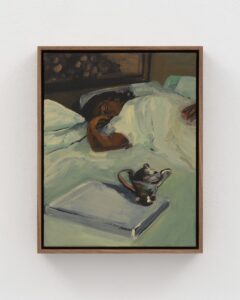At first glance, the image titled “Light” by ancientfawn presents a simple yet powerful visual: a tiger’s face rendered in haunting symmetry, its gaze fixed directly on the viewer, split cleanly down the middle by a streak of light. But the longer you look, the less static it becomes. It vibrates with energy, tension, and meaning. What seems like a portrait transforms into a meditation—on duality, perception, consciousness, and the eternal interplay between backdrop and illumination.
This image doesn’t just portray light. It interrogates it. What is light without its foil—darkness? And who are we, the viewers, when confronted by a gaze that sees us from both sides of that eternal spectrum?
Composition: The Division of Light and Silhouette
The structure of the image hinges on one deliberate compositional move: the vertical beam of light that bisects the tiger’s face. This division is not merely aesthetic—it’s thematic. It transforms the tiger’s countenance into two psychological states, two mythic forces, two metaphysical conditions.
On the left: warm light, golden fur, a clear eye—the domain of the seen, the known, the conscious self.
On the right: backdrop, desaturation, dimness—a plunge into obscurity, ambiguity, and unconscious depth.
The tight framing, which places the viewer uncomfortably close to the tiger, creates intimacy but also tension. The subject is not merely viewed—it confronts us. The image dares the viewer to meet its gaze, a gaze fractured yet whole, suggesting an identity made from two opposing truths.
Symbolism: The Tiger as Archetype
In literature and myth, the tiger often represents power, unpredictability, instinct, and sometimes divine wrath or balance. From Blake’s “The Tyger”—“burning bright in the forests of the night”—to the Hindu goddess Durga riding her tiger steed, this animal has long embodied primal forces. In “Light”, the tiger becomes more than animal—it becomes symbol.
- Left side (light): This side is calm, alert, alive. The eye gleams with clarity and warmth. It feels rational, even noble.
- Right side (dark): This side, cloaked in dimness, carries a weight. The eye is subdued, nearly lost in darkened depth. It seems subconscious, perhaps dangerous.
The division is not a judgment—neither side is good or evil. Instead, it renders the tiger as a complete being: half order, half chaos, half illumination, half mystery. This duality speaks to Jungian psychology—the concept of the noir archetype shading self. We all carry a side unseen, hidden not by accident, but by structure. “Light” captures that perfectly.
Light as Metaphor: Literal and Conceptual
Light here is not just illumination. It’s a metaphor for awareness, truth, and self-revelation. The beam does not just reveal—it defines. The line of light serves as:
- A mirror, splitting the self in two.
- A barrier, dividing consciousness from unconsciousness.
- A path, suggesting a journey inward or upward.
What’s remarkable is the lack of harsh contrast. The dark side is not pitch-black. The light side is not pure white. This nuance avoids simplistic dichotomies. Instead, it communicates gradation—that even in darkness there is detail, and in light, ambiguity.
Stylistic Execution: Digital Precision with Painterly Emotion
Ancientfawn’s style merges digital clarity with textural softness. The fur is rendered with subtle strokes, neither hyperrealistic nor abstract. The edges are soft, almost dissolving into the background. This creates a dreamlike quality—as though the tiger is materializing from mist, or retreating into it.
Notice the slight chromatic aberration effect—a touch of glitchy distortion, especially around the nose and whiskers. This visual noise is deliberate. It evokes a kind of interference—reality bending, the image warping like a memory. This isn’t just a picture—it’s a threshold, something seen in a moment of personal rupture or revelation.
The eyes are the focal point. One burns. One recedes. Both hold presence. This tension animates the whole image.
Literary and Philosophical Resonance
What makes “Light” resonate beyond its technical brilliance is how well it aligns with key themes from literature and philosophy. A few notable connections:
William Blake’s “The Tyger”
“Tyger Tyger, burning bright,
In the forests of the night…”
Blake’s eternal question—who or what could create something so beautiful and terrible? “Light” channels this same energy. The tiger isn’t a threat. It’s a question made flesh.
Carl Jung and the Dark Facade Colour
Jung believed each individual has a “backdrop”—the part of the psyche that remains unconscious. True individuation requires confronting this side. The image visualizes this confrontation. One side sees. The other watches from beneath.
Nietzsche’s Abyss
“And when you gaze long into an abyss, the abyss also gazes into you.”
In this piece, the tiger becomes that abyss. But rather than empty, it’s full. Full of history, instinct, memory, divinity.
Interpretive Lenses: Reading the Image Multiple Ways
A strength of “Light” is its interpretive openness. Here are a few alternate readings:
The Divided Self
The image can be seen as a portrait of internal conflict—between logic and emotion, instinct and reason. The light is not a solution, but a marker: the line where the two collide.
The Moment Before Action
There’s a stillness here, but not peace. It’s the quiet before movement—the tiger measuring a decision. The light may mark not identity but choice. Which way will it turn? What does it see?
A Cosmic Symbol
In a mythic reading, the tiger could represent a guardian or sentinel—a being that watches the boundary between worlds. The light is the veil between realms, and the tiger is its watcher.
Cultural Subtext and Modern Context
In modern visual culture, especially among digital artists, tigers and big cats are often stylized as totems, guides, or avatars of resilience and power. But ancientfawn sidesteps cliché. This isn’t just a majestic animal—it’s a philosophical subject. The aesthetic language—minimal, moody, resonant—places the work firmly within contemporary digital fine art, rather than illustrative or fan-based art spaces.
Flow
Despite its technical restraint, the emotional power of the piece is undeniable. The longer one looks, the more the tiger becomes a mirror. Not of the face, but of the inner life. The artwork does not provoke with drama. It moves with quiet force. It speaks in silence. It does not scream—but it demands attention.
Impression
“Light” by ancientfawn is more than a digital portrait. It is a meditation—on perception, duality, and the nature of inner vision. The split down the tiger’s face isn’t just clever composition—it’s a philosophical gesture. A reminder that we are all made of parts that see and parts that hide.
In an age of noise and spectacle, this piece does something radical: it invites stillness. It commands presence. It gives us, for just a moment, the gift of being seen—by something ancient, balanced, and beyond language.
It is a rare thing to encounter a visual work that feels like it understands you. “Light” doesn’t tell you what to feel. It shows you yourself. And that may be the most profound kind of art there is.
No comments yet.








